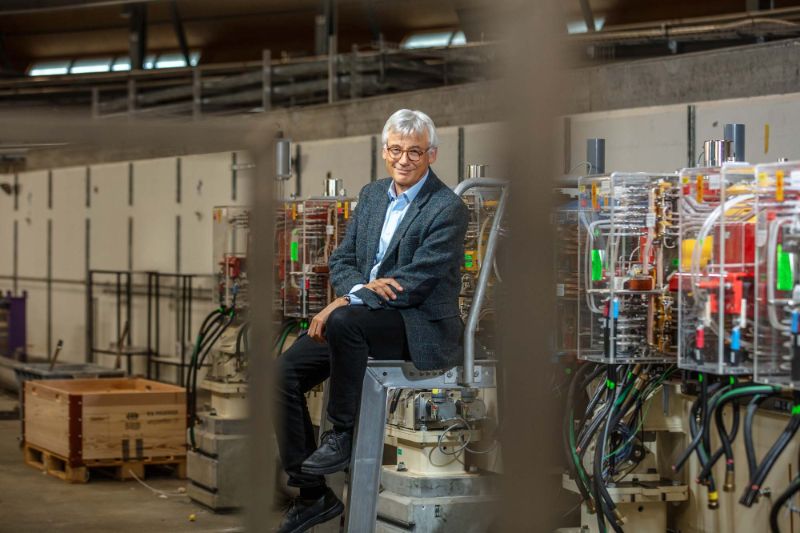The light inside the tunnel
These are “dark” times at the PSI in Villigen. But to stretch the metaphor a little further, you can already see the light at the end of the tunnel – or rather, inside the tunnel. We are welcomed by Hans-Heinrich Braun, project manager of “SLS 2.0”, who takes us to the most expressive building at the PSI. For a good 20 years now, a huge, round “UFO” has stood at the southern end of the complex. Its dimensions match the ring that is at the heart of the facility. Electrons travel through this ring – the Swiss Light source, or SLS for short – at almost the speed of light. Or at least they normally would.
Simultaneous construction and dismantling
During our visit in October 2023, the only things moving in the building are two massive industrial cranes. Braun points to one of them: “We had it specially installed to complete the conversion.” Things have to move quickly, which is why a lot of things overlap at the moment; in fact, construction and dismantling are happening at the same time. From an elevated walkway, with the best view down onto the facility, Braun explains what is happening: equipment is being diligently dismantled and removed, bolted and installed. A section of the new synchrotron, a thin copper tube in a metal frame, is already in place on one side.
Everything at the SLS is currently being changed. The facility will ultimately be shut down for 15 months, a long time considering the many experiments running simultaneously here before: 16 “beamlines” branch off from the ring to the experimental stations, which are distributed around the hall – primarily for various x-ray spectroscopy studies. The method lends itself to analyses of new materials as well as the study of protein crystals.
Balancing service and innovation
Industrial partners like to use the facility for the latter in particular. The PSI works closely with pharmaceutical companies, and the methods used are currently the gold standard for unravelling complex protein structures. In this respect, the PSI is more of a service provider than a basic research institute. Can the partners be expected to be kept waiting this long? In other words, given the competition with other synchrotron facilities, isn’t a shutdown of this kind problematic? Braun disagrees, saying not doing the conversion would be a problem. “Top researchers go to the best facilities.” And after 20 years of successful operation, without a comprehensive update, there is a risk of falling behind with technical developments.
Prototypes from PSI's own workshop
He adds that it was a stroke of luck that the synchrotron facility in Grenoble, the European Synchrotron Radiation Facility (ESRF), had also just been modernised, “so it was a bit of a trade-off.” Some experiments were moved to Villigen during the ESRF’s shutdown, and now researchers can do their work in Grenoble. Of course, the aim is to bring the top people back to the PSI, which is exactly what the conversion is all about. You can see and hear the anticipation when Braun talks about the new facility that is being built down below. According to Braun, after the conversion, much more intensive beamlines will be available, which will render experiments feasible that “would have taken years to complete” with the current equipment.
However, this also means that the synchrotron’s technology will be considerably more complex. Some of the challenges have been solved in the PSI’s own workshop, where prototypes for the state-of-the-art magnetic tube have been in development for some time. According to Braun, this gives the PSI a significant advantage when dealing with the companies entrusted with manufacturing, enabling it to negotiate “as equal partners.” After all, this often involves “procedures not found in any textbook.” The requirements for such a facility – the precision, the ultra-high vacuum allowing the electrons to have a free path – are similar to those found only in the production of computer chips.
Mastering the complexity
Braun oversaw the construction of the SwissFEL, where he learned not to lose sight of any detail, such as the processing of the volumes of data generated, which occasionally caused a bottleneck at the SwissFEL. As he sees it, this is the real challenge with such a large-scale project: all the different aspects that have to dovetail perfectly in the end.
New opportunities for the next generation of researchers
When you have all this explained to you, you begin to develop a growing respect for this monumental undertaking. And even if everything in the hall seems calm and focussed, you can imagine the pressure you are under when designing instruments that will open up new opportunities for the next generation of researchers: “We want to push the boundaries of what is possible – we want to explore the extreme.” Only around 400 days to go before the “dark” times are over.
